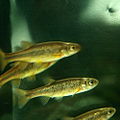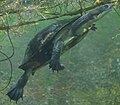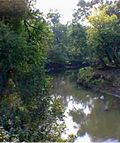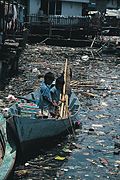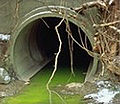Especialidades JA/Conservación medioambiental/Respuestas
| Conservación medioambiental | ||
|---|---|---|
| Asociación General
|
Destreza: 2 Año de introducción: 1973 |
|
Requisitos
|
La especialidad de Conservación Ambiental es un componente de la Maestría Conservación. |
| Conexión Logros para la Investidura: Esta especialidad está relacionada con los requisitos de Logros para la Investidura para VIAJERO AL AIRE LIBRE Estudio de la naturaleza que requiere (como una de dos opciones) completar el requisito #4 de esta especialidad. Esta especialidad es una elección popular para la especialidad de la categoría de Estudio de la naturaleza de nivel de destreza 2 o 3 requerido para los VIAJEROS AL AIRE LIBRE. |
1
- Ecología
- «ciencia que estudia las relaciones entre los seres vivos y su medio ambiente.»
- Conservación ambiental
- «proteger y preservar el futuro de la naturaleza, el medio ambiente o, específicamente, algunas de sus partes: la flora y la fauna, las distintas especies, los distintos ecosistemas, los valores paisajísticos, entre otros.»
2
Una amenaza importante para la existencia en la tierra hoy en día es el del cambio climático, que es el resultado del pecado, sobre todo en la forma de la codicia humana. La actividad humana que tiene el mayor efecto sobre el calentamiento es la liberación de gases de efecto invernadero como C02</ sub>. Para su investigación sobre este tema, consulte los siguientes artículos de Wikipedia:
Otros factores incluyen Deforestación.
God put several natural systems in place to sustain life on Earth including oceanic, atmospheric, fresh water, climate, and food production. As the result of human sin, all of these systems are rapidly decaying and have now reached the point of collapse.
Thus we see a tremendous increase in the frequency of natural disasters (100 year floods every year, hurricanes of unprecedented size, droughts, etc). We can also observe crop failures which result in food shortages. First world countries are largely insulated from the effects of these food shortages, but the impact is very real on poorer countries. For example, these food shortages are largely responsible for the "Arab Spring." People in the Middle East have lived under the rule of oppressive regimes for decades. It was only as a result of food price spikes that social upheaval was unleashed, followed quickly by the fall of governments all over the region (Tunisia, Egypt, Libya, Yemen), as well as the civil war in Syria.
We are seeing a fulfillment of Matthew 24:6-8 today. &
3
The death of a lake or river is said to occur when it becomes so polluted that it can no longer support life (such as fish, turtles, crustaceans, etc.). The most famous dead river is probably the Cuyahoga River in Ohio which actually caught on fire many times, helping to spur the environmental movement in the late 1960s.
Fires plagued the Cuyahoga beginning in 1936 when a spark from a blow torch ignited floating debris and oils. Fires erupted on the river several more times before June 22, 1969, when a river fire captured the attention of Time magazine, which described the Cuyahoga as the river that "oozes rather than flows" and in which a person "does not drown but decays."
This event helped spur an avalanche of pollution control activities resulting in the Clean Water Act, Great Lakes Water Quality Agreement, and the creation of the federal and state Environmental Protection Agency. As a result, large point sources of pollution on the Cuyahoga have received significant attention from the Ohio Environmental Protection Agency in recent decades.
Water quality has improved and, in recognition of this improvement, the Cuyahoga River was designated as one of 14 American Heritage Rivers in 1998. Pollution remains, however, including nonpoint source problems, Combined Sewer Overflows (CSOs), and stagnation due to water impounded by dams. For this reason, the Environmental Protection Agency classified portions of the Cuyahoga River Watershed as one of 43 Great Lakes Areas of Concern.
4
4a
4b
5
In the United States, environmental protection is managed by the government at all levels: local, state, and federal. It will be much easier to contact local or state officials rather than federal officials. Check the phone directory under "Environmental Protection" or search the Internet to find contact information for the agency in your area. If you are having difficulty finding the government body responsible for this in your area, try contacting a local paddling club, The American Canoe Association, or American Whitewater. These associations have a vested interest in clean rivers and streams (that's their playground!) and often organize river clean-up projects. They will be able to get you on a project, put you in touch with the most responsive government body, and recommend local businesses that are responsive to environmental conservation. You might also host a CITO event through Geocaching.com A well organized CITO will attract lots of willing volunteers.
6
- a. ¿Cuántas toneladas de basura se vierten a diario y anualmente? ¿anualmente?
- b. ¿Qué intento s son hechos por reciclar esta clase de basura?
- c. ¿La basura es quemada o toda es enterrada?
- d. ¿Cuál es costo por persona y por año para el manejo de la basura?
- e. ¿Qué sucede con vehículos viejos en su área?
Once you have made contact with the local government, they will be able to tell you how to get in touch with the solid waste management authority (if you don't know already). It could be that the government body you have been working with is the same one responsible for solid waste management. If this is the case, you previous efforts with them will pay another dividend - they will be eager to arrange a visit. You may also opt to contact the dump facility yourself and make arrangements for your visit.
This requirement overlaps a requirement in the Ecology honor. Working the honors together makes a lot of sense, and both count toward the Conservation Master Award
7
Again, you have an opportunity to use the contact you established with the local government. In most municipalities, the department responsible for the sewage plant is the same as the one responsible for the water plant. Make arrangement for both visits (see requirement 8) at the same time. Make sure to bring paper, pencil, and clipboards, and let the plant manager know ahead of time what questions you will be asking so that they can prepare.
8
See the answers to requirement 7 for more information.
9
Silent Spring is a book written by Rachel Carson and published by Houghton Mifflin in September 1962. The book is widely credited with helping launch the environmental movement in the West.
When Silent Spring was published, Rachel Carson was already a well-known writer on natural history, but had not previously been a social critic. The book was widely read (especially after its selection by the Book-of-the-Month Club and an endorsement by Supreme Court Justice William O. Douglas), spending several weeks on the New York Times best-seller list, and inspired widespread public concerns with pesticides and pollution of the environment. Silent Spring facilitated the ban of the pesticide DDT in 1972 in the United States.
The book documented detrimental effects of pesticides on the environment, particularly on birds. Carson said that DDT had been found to cause thinner egg shells and result in reproductive problems and death. She also accused the chemical industry of spreading disinformation, and public officials of accepting industry claims uncritically.
The book stated that uncontrolled pesticide use led to the deaths of not only animals, especially birds, but also humans. Its title was meant to evoke a spring season in which no bird songs could be heard, because they had all died from pesticides. Its title was inspired by a poem by John Keats, "La Belle Dame sans Merci", which contained the lines "The sedge is wither'd from the lake, And no birds sing."
10
See the Endangered Species honor for information on this requirement.
Referencias
- Categoría: Tiene imagen de insignia
- Adventist Youth Honors Answer Book/Honors/es
- Adventist Youth Honors Answer Book/es
- Adventist Youth Honors Answer Book/Skill Level 2/es
- Categoría: Libro de respuestas de especialidades JA/Especialidades introducidas en 1973
- Adventist Youth Honors Answer Book/General Conference/es
- Adventist Youth Honors Answer Book/Nature/es
- Adventist Youth Honors Answer Book/Nature/Primary/es
- Adventist Youth Honors Answer Book/Stage 100/es
- Adventist Youth Honors Answer Book/Conservation Master Award/es
- Adventist Youth Honors Answer Book/IAConnection/es


